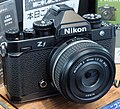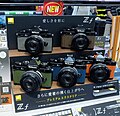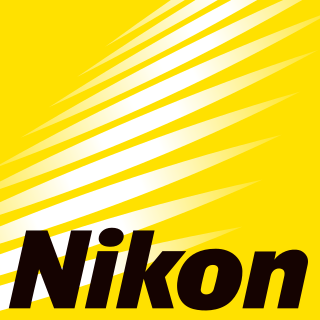
Nikon Corporation is a Japanese optics and photographic equipment manufacturer headquartered in Tokyo, Japan. The companies held by Nikon form the Nikon Group.

An autofocus optical system uses a sensor, a control system and a motor to focus on an automatically- or manually-selected point or area. An electronic rangefinder has a display instead of the motor; the adjustment of the optical system has to be done manually until indication. Autofocus methods are distinguished as active, passive or hybrid types.

A digital single-lens reflex camera is a digital camera that combines the optics and mechanisms of a single-lens reflex camera with a solid-state image sensor and digitally records the images from the sensor.
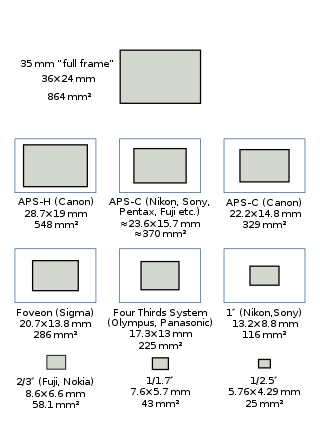
A full-frame DSLR is a digital single-lens reflex camera (DSLR) with a 35 mm image sensor format. Historically, 35 mm was one of the standard film formats, alongside larger ones, such as medium format and large format. The full-frame DSLR is in contrast to full-frame mirrorless interchangeable-lens cameras, and DSLR and mirrorless cameras with smaller sensors, much smaller than a full 35 mm frame. Many digital cameras, both compact and SLR models, use a smaller-than-35 mm frame as it is easier and cheaper to manufacture imaging sensors at a smaller size. Historically, the earliest digital SLR models, such as the Nikon NASA F4 or Kodak DCS 100, also used a smaller sensor.

Image stabilization (IS) is a family of techniques that reduce blurring associated with the motion of a camera or other imaging device during exposure.

A mirrorless camera is a digital camera which, in contrast to DSLRs, does not use a mirror in order to ensure that the image presented to the photographer through the viewfinder is identical to that taken by the camera. They have come to replace DSLRs, which have historically dominated interchangeable lens cameras. Other terms include electronic viewfinder interchangeable lens (EVIL) cameras and compact system cameras (CSCs).

A back-illuminated sensor, also known as backside illumination (BI) sensor, is a type of digital image sensor that uses a novel arrangement of the imaging elements to increase the amount of light captured and thereby improve low-light performance.

Single-lens translucent (SLT) is a Sony proprietary designation for Sony Alpha cameras which employ a pellicle mirror, electronic viewfinder, and phase-detection autofocus system. They employ the same Minolta A-mount as Sony Alpha DSLR cameras.

The Sony α7, α7R, α7S and α7C are four closely related families of full-frame mirrorless interchangeable-lens cameras. The first two were announced in October 2013, the third in April 2014 and the fourth in September 2020. They are Sony's first full-frame mirrorless interchangeable lens cameras and share the E-mount with the company's smaller sensor NEX series.

Nikon Z-mount is an interchangeable lens mount developed by Nikon for its mirrorless digital cameras. In late 2018, Nikon released two cameras that use this mount, the full-frame Nikon Z 7 and Nikon Z 6. In late 2019 Nikon announced their first Z-mount camera with an APS-C sensor, the Nikon Z 50. In July 2020 the entry-level full-frame Z 5 was introduced. In October 2020, Nikon announced the Nikon Z 6II and Nikon Z 7II, which succeed the Z 6 and Z 7, respectively. The APS-C lineup was expanded in July 2021, with the introduction of the retro styled Nikon Z fc, and in October 2021, Nikon unveiled the Nikon Z 9, which effectively succeeds the brand's flagship D6 DSLR. The APS-C lineup was further expanded with the Nikon Z 30, announced at the end of June 2022.

The Nikon Z 7 is a 45.7 megapixel full-frame mirrorless interchangeable-lens camera produced by Nikon. The camera was officially announced on August 23, 2018, for release in September 2018. It was the first camera to use Nikon's new Z-mount system; the second model, released in November 2018, was the 24.5 megapixel Nikon Z 6.

The Canon EOS R is the first full-frame mirrorless interchangeable-lens camera (MILC) produced by Canon. It was announced days after Nikon's first full-frame MILC, the Nikon Z 7, and five years after Sony's first, and was released in October 2018. The camera is the first of Canon's new EOS R system, and the first to use the RF lens mount. The "R" stands for "Reimagine optical excellence".
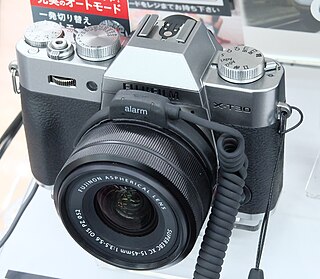
The Fujifilm X-T30 is a mirrorless interchangeable-lens camera announced by Fujifilm on February 14, 2019. The X-T30 is a successor to the X-T20, which was released in 2017. It is sold in three finishes: black, silver and charcoal silver.

The Fujifilm X-T4 is a mirrorless interchangeable-lens digital camera announced on February 25, 2020. It has a backside-illuminated X-Trans CMOS 4 APS-C sensor and an X-Processor 4 quad core processor and uses the Fujifilm X-mount. The X-T4 is a weather-resistant camera equipped with a higher-capacity battery designed to last longer than the X-T3. It is the successor to 2018's X-T3, which is a little smaller and lighter.

The Nikon Z 5 is a full-frame mirrorless interchangeable-lens camera produced by Nikon. The camera was officially announced on July 21, 2020, at the price of US$1,399.00. It is an entry-level full-frame camera that uses Nikon's Z-mount system.

The Fujifilm GFX100S is a mirrorless medium format camera produced by Fujifilm with Fujifilm G-mount. It is a smaller version of the 2019 GFX100 camera. The camera was announced by the corporation on January 27, 2021 at the X Summit Global 2021 together with the X-E4. Sales began in March 2021.

The Nikon Z 9 is a full-frame mirrorless camera produced by Nikon. The camera was announced on October 28, 2021.

The Canon EOS R7 is a high-end semi-professional APS-C mirrorless interchangeable-lens camera produced by Canon. The camera was announced by Canon on May 24, 2022 and released in Japan on June 23, 2022 Alongside the Canon EOS R10, the R7 is the first of two APS-C cameras in Canon's EOS R lineup. Two RF-S mount lenses were offered as kit lenses with the R7: the RF-S 18-150mm f/3.6-6.3 IS STM and the RF-S 18-45 f/4.5-6.3 IS STM.

The Fujifilm X-T5 is a mirrorless interchangeable-lens digital camera announced on November 2, 2022. It is the successor to 2020's X-T4 with improved autofocus, higher resolution and reduced body size. The 40.2 megapixels X-Trans 5 sensor is the highest-resolution APS-C sensor currently on the market.

The Nikon Z 8 is a high-end full-frame mirrorless camera produced by Nikon. The camera was announced on May 10, 2023. It is the tenth Z-mount camera body and the seventh full-frame Z-mount body.



